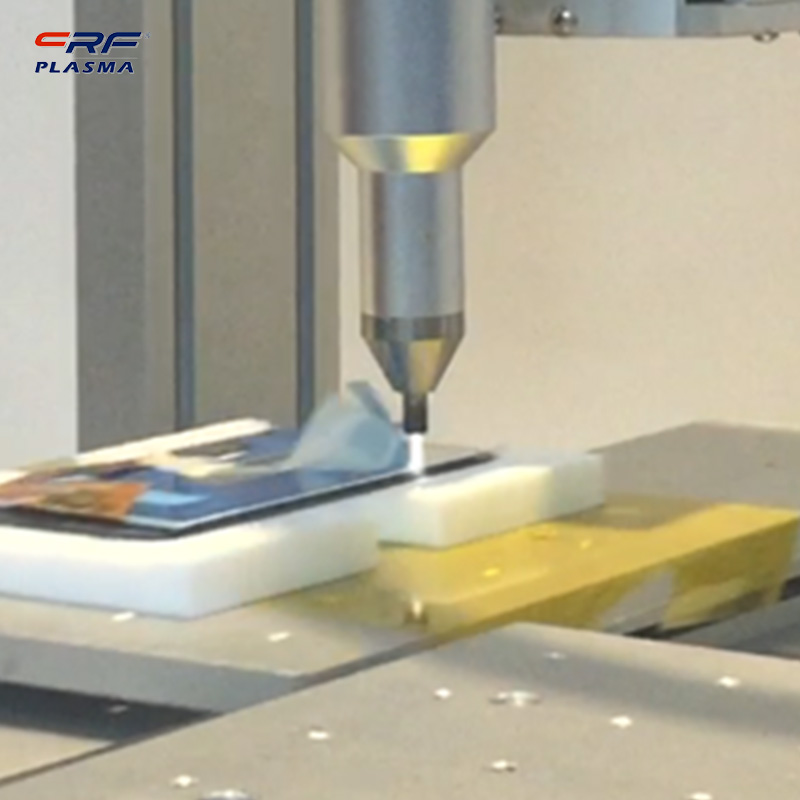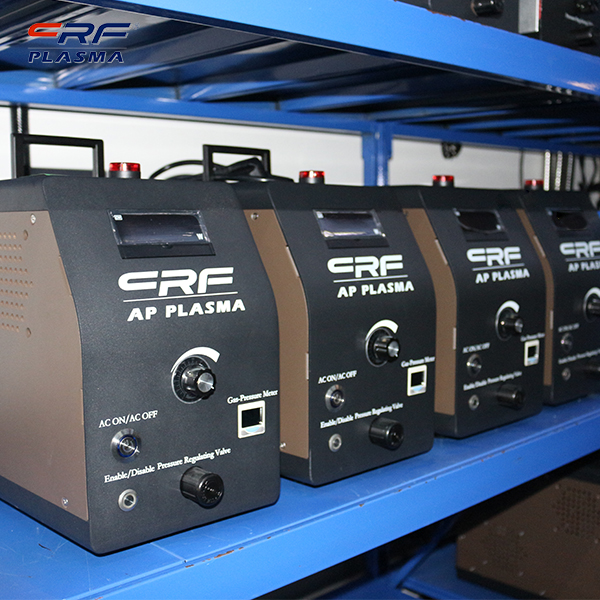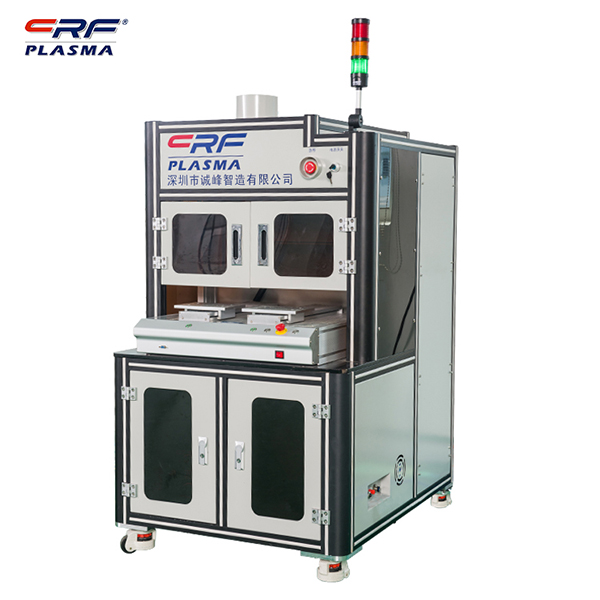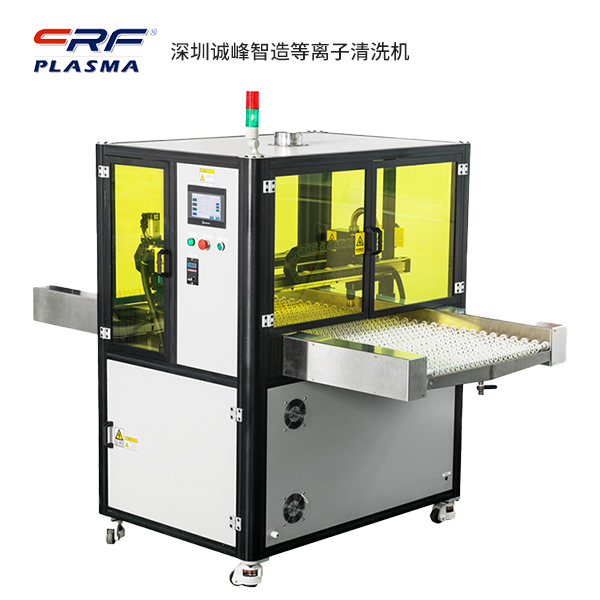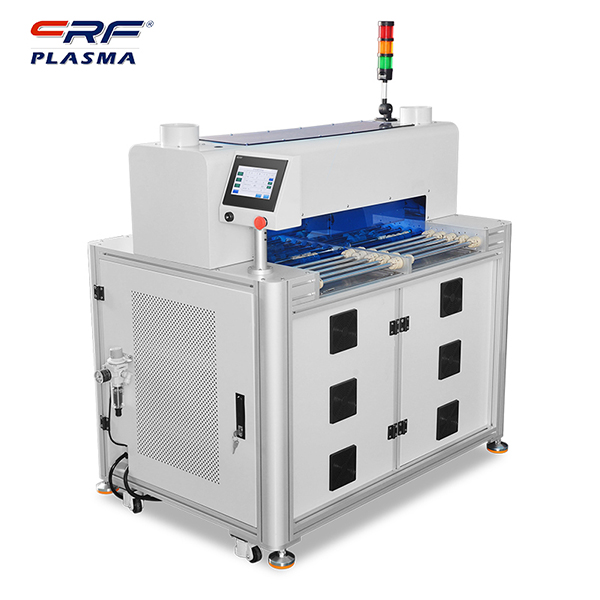
Welcome to Shenzhen Sing Fung Intelligent Manufacturing Co., Ltd.
E-mail:shaobo@sfi-crf.com
Comparison of plasma-modified MH-Ni polypropylene battery separator hollow cathode before and after remote treatment:
- Categories:Industry News
- Author:Plasma cleaning machine-CRF plasma plasma equipment-plasma surface treatment machine manufacturer-chengfeng intelligent manufacturing
- Origin:
- Time of issue:2022-03-31
- Views:
(Summary description)Comparison of plasma-modified MH-Ni polypropylene battery separator hollow cathode before and after remote treatment: Polypropylene has high chemical stability and good mechanical properties, small specific gravity and specific resistance, excellent air permeability, low price, low energy consumption, no pollution, and is an ideal battery separator substrate. However, because there are no hydrophilic groups in the macromolecular structure of polypropylene, the crystallinity is high, the fiber cross section is round, the structure is dense, and the lack of micropores and gaps, its hydrophilicity is extremely poor. In order to improve the wettability of polypropylene fiber separator to electrolyte, it can be treated by wetting method and surface modification method. In the wetting method, the hydrophilic group cannot be fixed on the surface of the separator material in a chemically bonded state, so the life span is short. Plasma surface modification is mainly to improve its hydrophilicity by introducing functional hydrophilic groups or depositing a hydrophilic polymer film on the surface of the polypropylene battery separator, so as to improve the alkali absorption performance of the separator. At present, most of them are directly processed by low temperature plasma discharge. However, the traditional low-temperature plasma discharge direct treatment method has disadvantages such as low ion concentration, low treatment efficiency, surface contamination and thermal stress, and its application scope is limited. The plasma concentration of radio frequency discharge can be increased by an order of magnitude, resulting in a higher polymerization rate. At the same time, the plasma is to place the experimental sample away from the plasma treatment area. The energy of the active particles in the far area is moderate. The plasma polymerization reaction has mild reaction, few side reactions, strong controllability, and polymerization grafting. The membrane structure is easy to control and so on. Plasma equipment modified the separator for alkaline secondary battery-MH-Ni battery, and the plasma treatment conditions affected the performance of polypropylene separator. The high alkali absorption of the diaphragm can effectively reduce the electrochemical polarization and concentration polarization of the electrode reaction, fully reduce the internal resistance of the battery during the charging and discharging process, make the discharge reaction more sufficient and complete, and improve the utilization rate of active materials. With the increase of air flow, the activated plasma state increases, and more acrylic acid is grafted faster. Therefore, the alkali absorption rate and alkali absorption rate of the polypropylene diaphragm are gradually increased. However, after reaching a certain flow rate, under the condition that the discharge power remains unchanged, the increase of the gas flow rate leads to an excessively high gas density, which makes the energy of a single charged particle smaller, and at the same time causes more energy loss in the collision between particles. , affecting the effect of acrylic polymer deposition. After plasma cleaning, the alkali absorption rate of the diaphragm decreases correspondingly, but the alkali absorption rate does not decrease much. This may be part of the buildup on the treated battery separator, the polyacrylic film is not firmly bonded to the polypropylene. After cleaning, this part of the polyacrylic acid film fell off, resulting in a great reduction in the rate of alkali absorption. The alkali absorption rate experiment was carried out after the treated diaphragm was fully infiltrated. Even if the alkali absorption rate of the diaphragm decreased, the total alkali absorption rate did not change much. The comparison between untreated polypropylene battery separator and plasma treatment shows that hydrophilic carboxyl groups are introduced on the surface of polypropylene fiber after plasma treatment. The untreated battery separator is relatively smooth, while the treated separator fibers are distributed with a sheet-like polyacrylic acid film, and the surface becomes rough. In addition, the characteristic peaks of polypropylene are still well preserved, indicating that although the separator has been treated, its own characteristics have not been affected.
Comparison of plasma-modified MH-Ni polypropylene battery separator hollow cathode before and after remote treatment:
(Summary description)Comparison of plasma-modified MH-Ni polypropylene battery separator hollow cathode before and after remote treatment:
Polypropylene has high chemical stability and good mechanical properties, small specific gravity and specific resistance, excellent air permeability, low price, low energy consumption, no pollution, and is an ideal battery separator substrate. However, because there are no hydrophilic groups in the macromolecular structure of polypropylene, the crystallinity is high, the fiber cross section is round, the structure is dense, and the lack of micropores and gaps, its hydrophilicity is extremely poor.
In order to improve the wettability of polypropylene fiber separator to electrolyte, it can be treated by wetting method and surface modification method. In the wetting method, the hydrophilic group cannot be fixed on the surface of the separator material in a chemically bonded state, so the life span is short. Plasma surface modification is mainly to improve its hydrophilicity by introducing functional hydrophilic groups or depositing a hydrophilic polymer film on the surface of the polypropylene battery separator, so as to improve the alkali absorption performance of the separator. At present, most of them are directly processed by low temperature plasma discharge. However, the traditional low-temperature plasma discharge direct treatment method has disadvantages such as low ion concentration, low treatment efficiency, surface contamination and thermal stress, and its application scope is limited.
The plasma concentration of radio frequency discharge can be increased by an order of magnitude, resulting in a higher polymerization rate. At the same time, the plasma is to place the experimental sample away from the plasma treatment area. The energy of the active particles in the far area is moderate. The plasma polymerization reaction has mild reaction, few side reactions, strong controllability, and polymerization grafting. The membrane structure is easy to control and so on.
Plasma equipment modified the separator for alkaline secondary battery-MH-Ni battery, and the plasma treatment conditions affected the performance of polypropylene separator. The high alkali absorption of the diaphragm can effectively reduce the electrochemical polarization and concentration polarization of the electrode reaction, fully reduce the internal resistance of the battery during the charging and discharging process, make the discharge reaction more sufficient and complete, and improve the utilization rate of active materials.
With the increase of air flow, the activated plasma state increases, and more acrylic acid is grafted faster. Therefore, the alkali absorption rate and alkali absorption rate of the polypropylene diaphragm are gradually increased. However, after reaching a certain flow rate, under the condition that the discharge power remains unchanged, the increase of the gas flow rate leads to an excessively high gas density, which makes the energy of a single charged particle smaller, and at the same time causes more energy loss in the collision between particles. , affecting the effect of acrylic polymer deposition.
After plasma cleaning, the alkali absorption rate of the diaphragm decreases correspondingly, but the alkali absorption rate does not decrease much. This may be part of the buildup on the treated battery separator, the polyacrylic film is not firmly bonded to the polypropylene. After cleaning, this part of the polyacrylic acid film fell off, resulting in a great reduction in the rate of alkali absorption. The alkali absorption rate experiment was carried out after the treated diaphragm was fully infiltrated. Even if the alkali absorption rate of the diaphragm decreased, the total alkali absorption rate did not change much.
The comparison between untreated polypropylene battery separator and plasma treatment shows that hydrophilic carboxyl groups are introduced on the surface of polypropylene fiber after plasma treatment. The untreated battery separator is relatively smooth, while the treated separator fibers are distributed with a sheet-like polyacrylic acid film, and the surface becomes rough. In addition, the characteristic peaks of polypropylene are still well preserved, indicating that although the separator has been treated, its own characteristics have not been affected.
- Categories:Industry News
- Author:Plasma cleaning machine-CRF plasma plasma equipment-plasma surface treatment machine manufacturer-chengfeng intelligent manufacturing
- Origin:
- Time of issue:2022-03-31 16:52
- Views:
Comparison of plasma-modified MH-Ni polypropylene battery separator hollow cathode before and after remote treatment:
Polypropylene has high chemical stability and good mechanical properties, small specific gravity and specific resistance, excellent air permeability, low price, low energy consumption, no pollution, and is an ideal battery separator substrate. However, because there are no hydrophilic groups in the macromolecular structure of polypropylene, the crystallinity is high, the fiber cross section is round, the structure is dense, and the lack of micropores and gaps, its hydrophilicity is extremely poor.
In order to improve the wettability of polypropylene fiber separator to electrolyte, it can be treated by wetting method and surface modification method. In the wetting method, the hydrophilic group cannot be fixed on the surface of the separator material in a chemically bonded state, so the life span is short. Plasma surface modification is mainly to improve its hydrophilicity by introducing functional hydrophilic groups or depositing a hydrophilic polymer film on the surface of the polypropylene battery separator, so as to improve the alkali absorption performance of the separator. At present, most of them are directly processed by low temperature plasma discharge. However, the traditional low-temperature plasma discharge direct treatment method has disadvantages such as low ion concentration, low treatment efficiency, surface contamination and thermal stress, and its application scope is limited.
The plasma concentration of radio frequency discharge can be increased by an order of magnitude, resulting in a higher polymerization rate. At the same time, the plasma is to place the experimental sample away from the plasma treatment area. The energy of the active particles in the far area is moderate. The plasma polymerization reaction has mild reaction, few side reactions, strong controllability, and polymerization grafting. The membrane structure is easy to control and so on.
Plasma equipment modified the separator for alkaline secondary battery-MH-Ni battery, and the plasma treatment conditions affected the performance of polypropylene separator. The high alkali absorption of the diaphragm can effectively reduce the electrochemical polarization and concentration polarization of the electrode reaction, fully reduce the internal resistance of the battery during the charging and discharging process, make the discharge reaction more sufficient and complete, and improve the utilization rate of active materials.
 With the increase of air flow, the activated plasma state increases, and more acrylic acid is grafted faster. Therefore, the alkali absorption rate and alkali absorption rate of the polypropylene diaphragm are gradually increased. However, after reaching a certain flow rate, under the condition that the discharge power remains unchanged, the increase of the gas flow rate leads to an excessively high gas density, which makes the energy of a single charged particle smaller, and at the same time causes more energy loss in the collision between particles. , affecting the effect of acrylic polymer deposition.
With the increase of air flow, the activated plasma state increases, and more acrylic acid is grafted faster. Therefore, the alkali absorption rate and alkali absorption rate of the polypropylene diaphragm are gradually increased. However, after reaching a certain flow rate, under the condition that the discharge power remains unchanged, the increase of the gas flow rate leads to an excessively high gas density, which makes the energy of a single charged particle smaller, and at the same time causes more energy loss in the collision between particles. , affecting the effect of acrylic polymer deposition.
After plasma cleaning, the alkali absorption rate of the diaphragm decreases correspondingly, but the alkali absorption rate does not decrease much. This may be part of the buildup on the treated battery separator, the polyacrylic film is not firmly bonded to the polypropylene. After cleaning, this part of the polyacrylic acid film fell off, resulting in a great reduction in the rate of alkali absorption. The alkali absorption rate experiment was carried out after the treated diaphragm was fully infiltrated. Even if the alkali absorption rate of the diaphragm decreased, the total alkali absorption rate did not change much.
The comparison between untreated polypropylene battery separator and plasma treatment shows that hydrophilic carboxyl groups are introduced on the surface of polypropylene fiber after plasma treatment. The untreated battery separator is relatively smooth, while the treated separator fibers are distributed with a sheet-like polyacrylic acid film, and the surface becomes rough. In addition, the characteristic peaks of polypropylene are still well preserved, indicating that although the separator has been treated, its own characteristics have not been affected.
Scan the QR code to read on your phone

TEL:0755-3367 3020 / 0755-3367 3019

E-mail:sales-sfi@sfi-crf.com

ADD:Mabao Industrial Zone, Huangpu, Baoan District, Shenzhen





